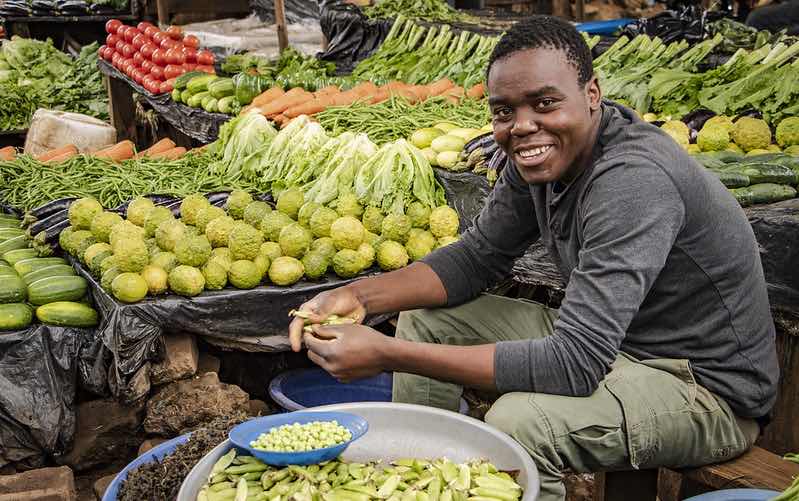The world continues to lose ground in its efforts to end hunger, food insecurity, and malnutrition in all its forms by 2030, according to the recently-released 2022 State of Food Security and Nutrition in the World (SOFI) report. As many as 828 million people were affected by hunger globally in 2021 (around 10.5% of the world population)—an increase of 46 million since the end of 2020 and of 150 million since the COVID-19 pandemic began a year earlier. The rise reflects continuing post-pandemic inequalities across and within countries due to uneven patterns of economic recovery and unrecovered income losses among those hit hardest.
The combination of pandemic fallout, conflict, and climate shocks has reversed previous progress, according to the report, a joint publication by the UN Food and Agriculture Organization (FAO), International Fund for Agricultural Development (IFAD), UNICEF, World Food Programme, and World Health Organization (WHO).
In particular, the report says, COVID-19 highlighted the fragilities of agrifood systems and inequalities within societies while driving up food insecurity and global hunger. Meanwhile, the ongoing war in Ukraine has further exacerbated food crises by disrupting international supply chains and pushing up the prices of grains, fertilizer, and energy.
All of these problems have contributed to an increased average cost of a healthy diets in all regions of the world, and has also undone previous progress in increasing food security and reducing malnutrition among children. Nearly 3.1 billion people globally were unable to afford a healthy diet in 2020, a jump of 112 million from 2019 due to the continuing stresses of pandemic and war. (The SOFI report employs a suite of new indicators developed by the Food Prices for Nutrition project, a partnership of IFPRI, Tufts University, and the World Bank that measures access to healthy diets around the world.)
Pandemic fallout, conflict, and climate-related shocks such as extreme weather continue to impede food supply chains, especially in low income countries and among vulnerable populations in different parts of the world. Africa bears the heaviest regional burden, with one in five people or 20.2% of the population undernourished compared to 9.1% in Asia, 8.6% in Latin America and the Caribbean, 5.8% in Oceania, and 2.5% in Northern America and Europe combined.
The report projects that if current trends continue—with only eight years remaining to achieve all the Sustainable Development Goals (SDGs)—nearly 670 million people or 8% of the world population will still be undernourished and facing hunger in 2030, same as the 2015 levels when the 2030 Agenda was launched, and 78 million more than in a scenario in which the pandemic had not occurred. In addition, the war in Ukraine continues to impact the trajectory of global food security and disrupt global agricultural markets, a sign of alarm for many countries in the near future.
Despite hopes that the world would recover quickly from the effects of the COVID-19 pandemic, global economic growth prospects for 2022 are significantly lower than previously expected, leaving many countries with limited financial resources to invest in agrifood systems. To meet the targets of SDG 2 (Zero Hunger), the report suggests reducing the costs of healthy diets by investing in production of more nutritious foods; efforts should also be made to influence consumer preferences towards them.
A key potential source of funds for these efforts, the report says, is repurposing the various types of public support for agriculture, which currently total almost $630 billion per year globally. Much of that is in the form of subsidies that distort market prices, contribute towards environment degradation and climate change, and hurt rural income generation prospects.
Along with the report, recent research by IFPRI in collaboration with the World Bank suggests that repurposing this support would achieve triple wins for people, planet, and the global prosperity. Investing instead in certain high-priority and nutritious foods for a healthy diet can reduce their costs while generating higher incomes for producers. Support for sustainable production methods will also help lower greenhouse gas emissions and reduce the overall carbon footprint of the agriculture sector.
International development support and public-private partnerships will be key to ease this transition in agriculture-dependent and low-income countries—helping them to implement necessary policies to create employment, improve rural livelihoods, and strengthen the overall economy. Altering existing trade policies and fiscal subsidies will require weighing countries’ commitments and flexibilities under the current WTO rules as well as in ongoing negotiations.
This transformation must be accompanied by policies that promote shifts in consumer behaviors toward heathier foods, along with improved social protection policies to safeguard vulnerable populations from any unintended consequences, the report says. It is crucial that these reforms be sustainable—they must be multisectoral and encompass health, environment, transportation, and energy policies—to benefit both the current and future generations.
Swati Malhotra is a Communications Specialist with IFPRI’s Markets, Trade, and Institutions Division.







